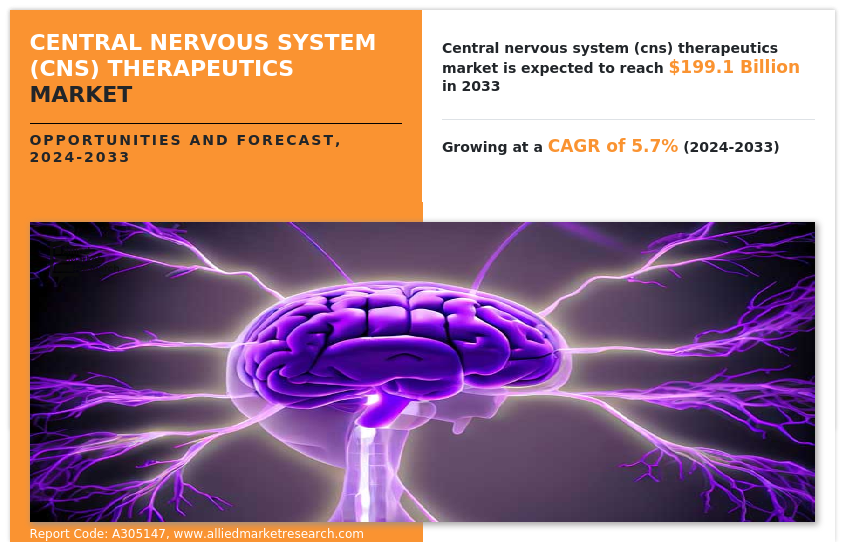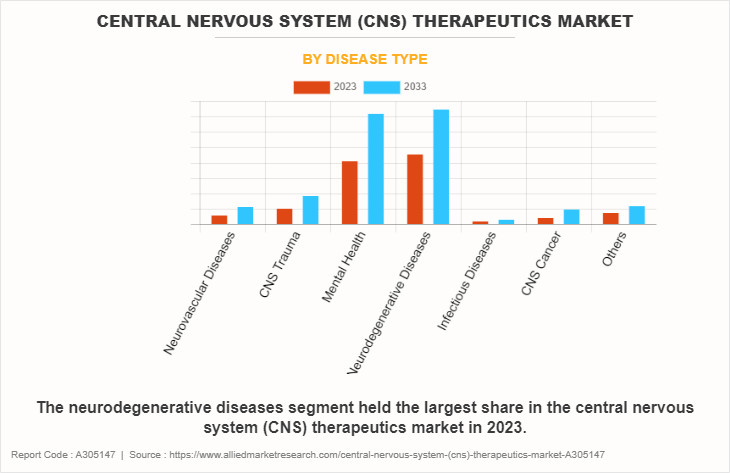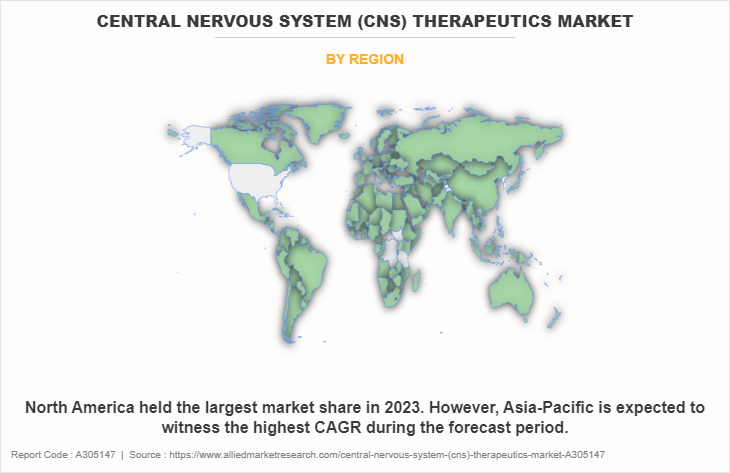Central Nervous System (CNS) Therapeutics Market Research, 2033
The global central nervous system therapeutics market size was valued at $114.2 billion in 2023 and is projected to reach $199.1 billion by 2033, growing at a CAGR of 5.7% from 2024 to 2033. The growth of the central nervous system (CNS) therapeutics market is driven by a surge in prevalence of the neurodegenerative disorders. For instance, according to a 2022 report by the National Library of Medicine, it was reported that the incidence of Alzheimer's disease doubles every 5 years, among the geriatric population. In addition, the surge in research and development to manufacture new drugs for the treatment of CNS disorders is also expected to drive the growth of the market.

Key Takeaways
- By disease type, the neurodegenerative diseases segment dominated the market in 2023, and is expected to remain dominant during the forecast period.
- By region, North America held the largest revenue share in 2023. However, Asia-Pacific is expected to grow at the fastest rate during the forecast period.
Central Nervous System (CNS) therapeutics encompass a wide range of drugs designed to target various disorders and conditions affecting the central nervous system, which includes the brain and spinal cord. These medications are crucial for managing neurological and psychiatric disorders by modulating neurotransmitter activity, altering neural pathways, or addressing underlying molecular and cellular abnormalities.
Market Dynamics
The CNS therapeutics market size is expected to grow significantly, owing to surge in neurodegenerative diseases, rise in the traumatic injury causing CNS trauma, surge in incidence of brain cancer, and rise in efforts in research and development for drug discovery and development.
The surge in neurodegenerative diseases has emerged as a significant catalyst propelling the growth of the central nervous system therapeutics industry. Neurodegenerative disorders, such as Alzheimer's disease, Parkinson's disease, and multiple sclerosis among others, have witnessed a notable increase in prevalence globally, leading to an escalating demand for effective treatment options. For instance, according to 2023 report by World Health Organization, it was estimated that over 1.8 million people have multiple sclerosis worldwide. The aging population, coupled with lifestyle factors and environmental changes, has contributed to the rise in the incidence of these debilitating conditions. As individuals live longer, the likelihood of encountering neurodegenerative diseases amplifies, thereby necessitating advanced therapeutic interventions. This heightened prevalence has sparked intensified research and development efforts in the pharmaceutical and biotechnology sectors to innovate novel CNS therapeutics.
Furthermore, surge in prevalence of traumatic injuries causing CNS trauma is expected to drive the growth central nervous system therapeutics industry. Traumatic injuries, including those sustained through accidents, falls, or other unforeseen events, often result in severe damage to the central nervous system. This increase in traumatic incidents has consequently elevated the incidence of CNS-related disorders and conditions, such as traumatic brain injuries and spinal cord injuries. For instance, according to 2022 report by National Library of Medicine, it was estimated that about 1.5 million Americans survive a traumatic brain injury (TBI) each year. As a consequence, there is a growing demand for effective therapeutic interventions to address the complex and intricate challenges associated with CNS trauma. Thus, the rise in CNS traumatic injuries is expected to drive the growth of the market.
In addition, CNS therapeutics market trends such as surge in incidence of brain cancer is expected to contribute significantly to the growth of the market. Brain cancer, characterized by the abnormal and uncontrollable growth of cells within the brain, poses a significant health challenge globally. The rise in brain cancer incidence can be attributed to various factors, including genetic predisposition, environmental factors, and lifestyle choices. Additionally, advancements in diagnostic technologies and increased awareness have led to earlier detection of brain tumors, contributing to the apparent increase in reported cases. The increasing prevalence of brain cancer cases has heightened the demand for effective treatment options and therapeutic interventions targeting the central nervous system. The complexity and diversity of brain cancer types necessitate the development of advanced CNS therapeutics to address specific subtypes and improve patient outcomes.
Moreover, the rise in research and development in the field of neurology is expected to drive the growth of the market. The notable upswing in research and development activities can be attributed to several factors, including an enhanced understanding of the intricate workings of the central nervous system, coupled with advancements in technology and methodologies that have facilitated scientific research. The escalating prevalence of neurological disorders, such as Alzheimer's disease, Parkinson's disease, and various neuropsychiatric conditions, has spurred a sense of urgency among researchers to explore innovative therapeutic interventions. Consequently, pharmaceutical and biotechnology companies have intensified their focus on neurology-related R&D initiatives, seeking novel drug candidates and therapeutic modalities that target specific pathways and mechanisms implicated in neurological disorders.
Furthermore, the investment by government and private organizations also encourages the research to advance their research in the field of neurology. For instance in 2023, the National Institutes of Health (NIH) funding for brain tumor research saw a considerable increase of approximately $20 million. In addition, in June 2023, Children’s National Hospital announced a $96 million investment from an anonymous donor family to transform rare childhood brain tumor research and care. Thus, the rise in research and development in the field of neurology expands the understanding of various CNS disorders and thus facilitates new drug development programs thereby contributing to the central nervous system therapeutics market growth.
However, the high cost of central nervous system therapeutics might restrain the growth during the central nervous system therapeutics market forecast. The development of medications targeting the central nervous system involves a complex and resource-intensive process, including extensive research, clinical trials, and regulatory approvals. These complex procedures incur substantial expenses, which are ultimately reflected in the pricing of CNS therapeutics. As a result, the high financial burden placed on both pharmaceutical companies and patients seeking these therapeutics acts as a significant restraint, limiting access and affordability. Thus, the high cost of the central nervous system therapeutics might negatively impact its adoption and drive the growth during CNS therapeutics market forecast.
The 2023 global recession poses challenges for the central nervous system therapeutics market. As inflation escalates, the cost of raw materials, equipment, and technology required for research and production of central nervous system therapeutics may surge, thereby increasing the overall operational expenses for companies operating in the central nervous system therapeutics market. This financial strain could potentially lead to a slowdown in research and development efforts, hindering the introduction of innovative therapeutics. Moreover, the escalating cost of healthcare services may result in reduced healthcare budgets. However, rise in geriatric population and surge in prevalence of neurodegenerative disorders are expected to drive the demand for central nervous system therapeutics.
Segmental Overview
The CNS therapeutics market is segmented based on disease type and region. By disease type, it is divided into neurovascular diseases, CNS trauma, mental health, neurodegenerative diseases, infectious diseases, cancer, and others. The mental health segment is further segmented into mental health anxiety disorders, epilepsy, mood disorders, psychotic disorders, and others. In addition, neurodegenerative diseases is further classified into Alzheimer’s disease, Parkinson’s disease, multiple sclerosis, Huntington’s Disease, amyotrophic lateral sclerosis, and others. Region-wise, the market is analyzed across North America (the U.S., Canada, and Mexico), Europe (Germany, France, the UK, Italy, Spain, and rest of Europe), Asia-Pacific (China, Japan, Australia, India, South Korea, and rest of Asia-Pacific), and LAMEA (Brazil, South Africa, Saudi Arabia, and rest of LAMEA).
By Disease Type
Based on disease type, the market is categorized into neurovascular diseases, CNS trauma, mental health, neurodegenerative diseases, infectious diseases, cancer, and others. The neurodegenerative diseases segment acquired CNS therapeutics market share revenue contributor in 2023 and is expected to remain dominant during the forecast period owing to surge in prevalence of neurodegenerative diseases such as Parkinson’s disease, multiple sclerosis, Alzheimer’s disease among others.

By Region
On the basis of region, the central nervous system (CNS) therapeutics market is analyzed across North America, Europe, Asia-Pacific, and LAMEA. North America held largest central nervous system therapeutics market share in 2022, owing to high number rise in geriatric population, and well-developed healthcare infrastructure and strong presence of major key players. In addition, the funding from various government and public organization for the research and development in the central nervous system (CNS) therapeutics is expected to drive the growth of the market.
However, Asia-Pacific is expected to exhibit fastest growth during the central nervous system therapeutics market analysis, owing to large patient pool in the Asia-Pacific region. In addition, the surge in prevalence of the mental health disorders such as anxiety and depression is expected to drive the growth of the market in the Asia-Pacific region.

Competition Analysis
Competitive analysis and profiles of the major players in the central nervous system therapeutics market, such as Biogen Inc, Johnson and Johnson, Eli Lilly and Company Inc, Merck and Co. Inc, F. Hoffmann-La Roche, Novartis AG, Takeda Pharmaceuticals, Viatris, UCB, and Teva Pharmaceutical Industries Ltd, are provided in the report.
Major players have adopted product launch, agreement, acquisition, product approval, and collaboration as key developmental strategies to improve the product portfolio and gain strong foothold in the central nervous system therapeutics market.
Recent Developments in the CNS Therapeutics Industry
Recent Product Launch in the CNS Therapeutics Market
In August 2023, Teva Pharmaceuticals launched AUSTEDO, a drug for the treatment of chorea associated with Huntington's disease and for the treatment of tardive dyskinesia in adults in Brazil. AUSTEDO is a new once-daily formulation indicated in adults for tardive dyskinesia (TD) and chorea associated with Huntington’s disease (HD). AUSTEDO XR is an additional formulation of the currently marketed twice-daily AUSTEDO.
Recent Agreement in the CNS Therapeutics Market
In February 2021, Eli Lilly and Company and Rigel Pharmaceuticals, Inc. announced a license agreement to co-develop and commercialize Rigel's R552, a receptor-interacting serine/threonine-protein kinase 1 (RIPK1) for the potential treatment of neurodegenerative disease. Under the collaboration, Lilly will also lead all clinical development of brain penetrating RIPK1 inhibitors in central nervous system (CNS) diseases.
Recent Acquisition in the CNS Therapeutics Market
In July 2023, Novartis acquired DTx Pharma, a San Diego-based, preclinical-stage biotechnology company focused on leveraging its proprietary FALCON platform to develop siRNA therapies for neuroscience indications. DTx’s lead program, DTx-1252 targets the root cause of CMT1A—the overexpression of PMP22, a protein that causes the myelin sheath that supports and insulates nerves in the peripheral nervous system to function abnormally. DTx-1252, which was recently granted Orphan Drug Designation by the U.S. Food and Drug Administration (FDA), decreases the expression of this protein in Schwann cells, the target cell type for the development, maintenance, and function of peripheral nerves.
Recent Product Approval in the CNS Therapeutics Market
In August 2023, Sandoz received FDA approval for Tyruko (natalizumab-sztn), the first and only FDA-approved biosimilar for relapsing forms of multiple sclerosis. Tyruko is approved as a monotherapy to treat all indications covered by reference medicine Tysabri (natalizumab) for relapsing forms of MS, including clinically isolated syndrome (CIS), relapsing-remitting MS (RRMS) and active secondary progressive disease, as well as Crohn’s disease in adults.
Recent Collaboration in the CNS Therapeutics Market
In January 2020, Eli Lilly had announced collaboration with UK biotech Evox Therapeutics, for central nervous system research to focus on drug engineering using vesicles to deliver drugs to targets. During this research collaboration and five-target license agreement, Evox will be responsible for exosome engineering in order to achieve brain/CNS-targeting, drug loading and analytics and some in vitro assay development, as well as material supply for initial in vivo studies.
Key Benefits For Stakeholders
- This report provides a quantitative analysis of the market segments, current trends, estimations, and dynamics of the market analysis from 2023 to 2033 to identify the prevailing central nervous system therapeutics market opportunity.
- The market research is offered along with information related to key drivers, restraints, and opportunities.
- Porter's five forces analysis highlights the potency of buyers and suppliers to enable stakeholders make profit-oriented business decisions and strengthen their supplier-buyer network.
- In-depth analysis of the CNS therapeutics market segmentation assists to determine the prevailing market opportunities.
- Major countries in each region are mapped according to their revenue contribution to the global market.
- Market player positioning facilitates benchmarking and provides a clear understanding of the present position of the market players.
- The report includes the analysis of the regional as well as global central nervous system therapeutics market trends, key players, market segments, application areas, and market growth strategies.
Central Nervous System (CNS) Therapeutics Market Report Highlights
| Aspects | Details |
| Market Size By 2033 | USD 199.1 billion |
| Growth Rate | CAGR of 5.7% |
| Forecast period | 2023 - 2033 |
| Report Pages | 246 |
| By Disease Type |
|
| By Region |
|
| Key Market Players | Viatris Inc., Novartis AG, Johnson and Johnson, Eli Lilly and Company., Merck & Co Inc, UCB Pharma, Teva Pharmaceutical Industries Ltd., F. Hoffmann-La Roche AG, Biogen, Takeda Pharmaceutical Company Ltd. |
Analyst Review
The central nervous system (CNS) therapeutics market has been witnessing significant growth and innovation driven by advancements in neurology research, molecular biology, and neuroimaging technologies. The rising prevalence of neurological disorders, including Alzheimer's disease, Parkinson's disease, and various psychiatric conditions, has resulted in increased investment in the development of novel therapeutics. Pharmaceutical companies are actively engaged in the discovery and development of innovative drugs for central nervous system disorders.
On a regional level, North America continues to dominate the central nervous system (CNS) therapeutics market, owing to the presence of major key players, coupled with substantial investments in research and development by pharmaceutical companies, and rise in prevalence of mental health disorder. However, the Asia-Pacific region is witnessing rapid growth, driven by rise in geriatric population, improving healthcare infrastructure, and favorable government initiatives.
The growth of the central nervous syatem (CNS) therapeutics market is primarily driven by rise in geriatric population and surge in research and development to develop new drugs for treatment of the central nervous system disorders. The rise in geriatric population stands as a pivotal driver for the growth of the central nervous system (CNS) therapeutics market.
The neurodegenerative disease segment is the most influencing segment in central nervous syatem (CNS) therapeutics market owing to a surge in prevalence of neurodegenerative disorders globally. Neurodegenerative disorders, such as Alzheimer's disease, Parkinson’s disease, multiple sclerosis, Huntington's disease, Amyotrophic lateral sclerosis, have seen a rise in prevalence globally.
Central nervous system (CNS) therapeutics encompass a wide range of drugs designed to target and modulate the functioning of the central nervous system, which includes the brain and spinal cord.
The Biogen Inc, Johnson and Johnson, Eli Lilly and Company Inc, Merck and Co. Inc, F. Hoffmann-La Roche AG, Novartis AG, Takeda Pharmaceuticals, Viatris, UCB, and Teva Pharmaceutical Industries Ltd. held a high market position in 2023.
The base year is 2023 in central nervous syatem (CNS) therapeutics market.
The market value of central nervous syatem (CNS) therapeutics market in 2033 is $199,098.30 million.
The forecast period for central nervous syatem (CNS) therapeutics market is 2024 to 2033.
The total market value of central nervous syatem (CNS) therapeutics market is $114,145.58 million in 2023.
Loading Table Of Content...
Loading Research Methodology...



